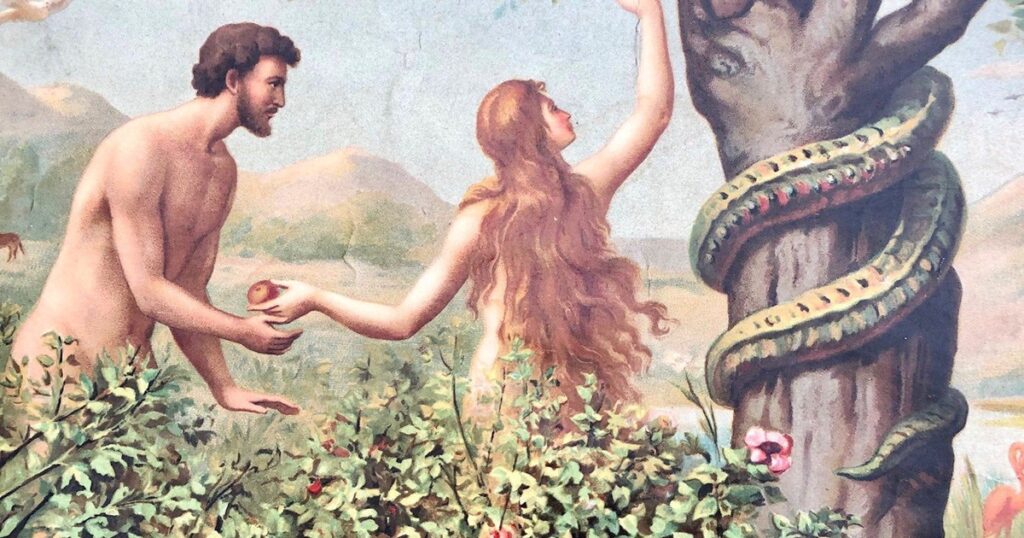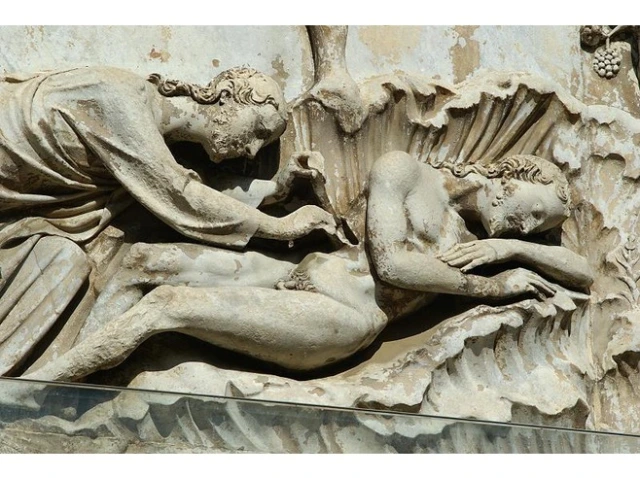Adam, the primordial man in the Bible, occupies a unique and foundational place in the annals of human history as told by the Judeo-Christian tradition. As the premier human being, crafted directly by the divine hand from the dust of the ground and imbued with life through God’s own breath (Genesis 2:7), Adam’s story intertwines threads of creation, morality, disobedience, and consequences in a narrative tapestry of profound religious and philosophical significance.
Who was Adam in the Bible?
Adam is a prominent figure in the Genesis narrative of the Hebrew Bible and Christian Old Testament. As per the creation narrative, he is traditionally recognized as the first human being, created by God (Yahweh) from “dust of the ground” or “clay” and given life by divine breath (Genesis 2:7).
The character of Adam in the Bible is multifaceted and has been the subject of diverse interpretations in theological, philosophical, and anthropological discussions. On a literal level, Adam, whose name in Hebrew signifies “human,” embodies the human condition in its inception, including aspects of innocence, obedience, temptation, and moral responsibility.
According to the biblical narrative, Adam was placed in the Garden of Eden to “work it and keep it” (Genesis 2:15), symbolizing humanity’s entrusted stewardship over creation. It is within this garden that the narrative of Adam and Eve unfolds, bringing concepts such as temptation, sin, and disobedience into focus.
When Eve, the first woman—whom God created from Adam’s rib to be his companion—ate the fruit from the Tree of Knowledge of Good and Evil, both she and Adam disobeyed God’s command not to eat from that tree (Genesis 2:16-17, 3:1-6). As a consequence of this original sin, both were expelled from the Garden of Eden, marking the fall of man and the commencement of human mortality and suffering (Genesis 3:16-24).
Interpreters often see in Adam a prototype of humanity, where his actions represent the fundamental nature and consequences of human choices. The New Testament further develops this typological approach, contrasting Adam with Jesus Christ. In Pauline theology, specifically in Romans 5:12-21 and 1 Corinthians 15:21-22, Adam’s disobedience leads to condemnation for all humans, while Jesus’s obedience leads to justification and life.
The historical or literal existence of Adam has been the subject of debate, especially in the context of scientific discoveries relating to human evolution. Nonetheless, regardless of one’s stance on Adam’s historicity, his figure holds a profound and enduring symbolic significance in Judeo-Christian thought, serving as an archetypal representation of humanity, its struggles, moral dilemmas, and the possibilities of redemption and transformation.
How was Adam created?
In the biblical narrative, the creation of Adam, the first human being, is depicted as a divine act performed by God (Yahweh). The description of Adam’s creation occurs in the second chapter of Genesis, the first book of the Hebrew Bible and Christian Old Testament. The narrative presents a two-stage process involving both the formation of the physical body and the imparting of life to that body.
Genesis 2:7 narrates, “Then the LORD God formed a man from the dust of the ground and breathed into his nostrils the breath of life, and the man became a living being.” This verse employs a potter’s metaphor to portray God shaping Adam’s body from the “dust of the ground” or “clay,” indicative of the basic material substance of the earth. This symbolism conveys the intrinsic connection and interdependence of human beings with the natural world.
The second part of the process is the infusion of life into the created body. God “breathed into his nostrils the breath of life.” This breath (in Hebrew, “neshama”) is portrayed as the life-giving force that animates the physical form, resulting in a “living being” or “living soul” (Hebrew “nephesh”). This breath or spirit of life, directly imparted by God, signifies the divine source of life and underscores the sacredness of human life.
The method of Adam’s creation implies both the dignity and the humility of human existence—the dignity derived from the divine breath that animates human life, and the humility stemming from the earthly materials constituting the human body.
While the narrative is not a scientific account and indeed predates modern scientific understanding of human origin by millennia, it communicates profound metaphysical and existential assertions about humanity. It presents a theological vision of human beings as a unique amalgamation of the material and the divine, living in intimate connection with the natural world while bearing the imprint of the divine breath.
Did Adam and Eve really exist?
The existence of Adam and Eve, as historical individuals, has been the subject of extensive debate across multiple disciplines including theology, philosophy, history and science. The crux of the question hinges on the interpretive approach one adopts toward the biblical narrative—literal, allegorical, or somewhere in between—and on how one reconciles this with empirical scientific findings.
From a purely literal interpretation of the Genesis narrative, one would affirm that Adam and Eve were historical individuals, the first human beings created directly by God. This interpretation has been upheld in certain traditional religious circles. However, this perspective often grapples with challenges posed by scientific disciplines, particularly by evolutionary biology and genetics.
The theory of evolution, supported by a robust body of empirical evidence, posits a gradual development of life forms over billions of years, with modern humans (Homo sapiens) emerging approximately 300,000 years ago. This stands in contrast to the sudden creation of a single human pair as described in the Genesis account.
Moreover, population genetics also provides substantial evidence that the human population has never been as small as two individuals. Analyses of genetic variation suggest that the effective population size of the earliest humans was more likely in the thousands.
In response to these challenges, some religious scholars and theologians have proposed non-literal, allegorical interpretations of the Genesis narrative. They suggest that Adam and Eve may symbolize the earliest humans or a group of early humans, or that the narrative serves as a mythical or symbolic account to convey theological truths about human nature, relationship with God, and moral responsibility, rather than a precise historical or scientific account.
Meaning of Adam’s rib in creating Eve
In the biblical account found in Genesis 2:21-22, God forms Eve, the first woman, from one of Adam’s ribs. This detail carries significant symbolic and theological implications within the Judeo-Christian tradition.
Firstly, the creation of Eve from Adam’s rib signifies the fundamental equality and mutual interdependence of men and women. The fact that Eve is not made from Adam’s head (suggesting superiority) nor from his feet (suggesting inferiority), but from his rib (close to his heart) is seen as an indication of parity and companionship. This interpretation is echoed in Adam’s exclamation upon seeing Eve: “This is now bone of my bones and flesh of my flesh” (Genesis 2:23), suggesting recognition, affinity, and equality.
Secondly, the narrative of Eve’s creation from Adam’s rib presents the institution of marriage in a theological context. Genesis 2:24 follows the creation account with the pronouncement: “Therefore a man leaves his father and his mother and clings to his wife, and they become one flesh.” This verse is often interpreted as a divinely ordained prescription for marital unity, symbolizing the intimate and indissoluble bond between husband and wife. The ‘one flesh’ motif, which may be seen as harkening back to Eve’s creation from Adam’s flesh, has been a cornerstone in Judeo-Christian matrimonial theology.
Finally, the creation of Eve from Adam’s rib underlines the shared humanity of men and women. As both are made of the same ‘material’, it undergirds the concept of a common human nature and destiny, irrespective of gender differences.
While this narrative, like much of biblical literature, is steeped in symbolism and should not be conflated with historical or scientific fact, it nevertheless has profoundly influenced cultural and religious understandings of gender, marriage, and human identity within the Judeo-Christian tradition. It is also subject to various interpretations and critiques, particularly in light of contemporary understandings of gender and relationships.
The original sin committed by Adam and Eve
The term “Original Sin” typically refers to the first moral transgression committed by Adam and Eve, as narrated in the third chapter of the Book of Genesis in the Hebrew Bible and Christian Old Testament. It is a central concept in Christian theology, signifying the fallen state of human nature, and is seen as having far-reaching consequences for all of humanity.
The sin itself is constituted by the disobedience of a direct divine command. According to the narrative, God instructs Adam not to eat from the Tree of Knowledge of Good and Evil, which is situated in the Garden of Eden where Adam and Eve reside. God warns, “You are free to eat from any tree in the garden; but you must not eat from the tree of the knowledge of good and evil, for when you eat from it you will certainly die” (Genesis 2:16-17).
However, influenced by the persuasive words of a serpent, who assures her that they would not die but rather become like God knowing good and evil, Eve decides to eat the fruit from the forbidden tree. She also gives some to Adam, who eats it as well. Thus, they both transgress God’s command, committing the original sin (Genesis 3:1-6).
This act of disobedience is often interpreted symbolically to represent a human assertion of autonomy from God, a striving to transcend human limitations, or an inability to resist temptation. It signifies humanity’s misuse of free will and their inclination towards moral transgression.
The repercussions of the original sin are immediate and severe. Both Adam and Eve become aware of their nakedness, experience shame, and hide from God, symbolizing a rupture in their relationship with God. Ultimately, they are expelled from the Garden of Eden, a punishment that symbolizes spiritual and physical death.
In Christian theology, the original sin is seen as introducing a state of sin that taints all of humanity. The apostle Paul in his letters—specifically in Romans 5:12-21—discusses how through Adam’s sin, death entered the world, affecting all humans. This belief informs the Christian understanding of the necessity of redemption and salvation through Jesus Christ.
What does the story of Adam and Eve teach us?
The story of Adam and Eve in the Bible provides foundational teachings within the Judeo-Christian tradition. This narrative, laden with symbolism, delves into several core themes, including obedience and disobedience, temptation, sin, responsibility, punishment, and the nature of human existence.
The first lesson emanates from the divine command given to Adam not to eat from the Tree of Knowledge of Good and Evil (Genesis 2:17). When both Adam and Eve contravene this command after being tempted by the serpent, they commit what is often termed as the “original sin.” This disobedience serves as a paradigmatic instance of human beings exercising free will in defiance of divine directives. It encapsulates the capacity of humans to discern and choose between obedience and rebellion, and the moral and existential consequences that follow from such choices.
The narrative further offers a nuanced exploration of temptation and deception. The serpent’s successful temptation of Eve (Genesis 3:1-6), leading to the disobedience of both Adam and Eve, highlights the complexities of temptation and the susceptibility of humans to external and internal persuasions that steer them away from moral rectitude.
Adam and Eve’s immediate reaction after their transgression—hiding from God and shifting blame when confronted (Genesis 3:8-13)—brings to the fore the theme of human evasion of responsibility. It underscores the propensity to shirk personal accountability for one’s actions and to attribute blame to others.
The punishment that follows their disobedience—expulsion from the Garden of Eden and the introduction of hardship into human life—expresses the biblical concept of divine justice, where actions have consequences (Genesis 3:16-24). However, it also signals the transition of humanity from an idyllic state to one marked by struggle, mortality, and labor.
Despite the fall, the narrative subtly introduces the theme of grace and hope for humanity. This is seen in God’s provision of garments for Adam and Eve (Genesis 3:21), a sign of divine care even in their fallen state.











